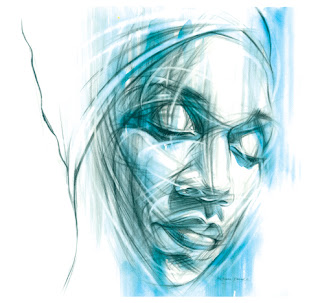"To be a woman in Western Society is to be a member, arguably of an oppressed majority (even though we are in the age of equality) To be black in this society is to be a different form of ' the other'.
We are move away from the concept of 'the other' - looking only at gender and sexuality (project 20-22) into the subject of racial issues
Task to read Fact of Blackness by Franz Fanon (course reader)
Fanon (1925-1961) was a post colonial writer born in the French colony of Martinique. After the 2nd world war he stayed in France to begin his academic career. When he was working in Algeria the war for Independence broke out and he aligned himself to the Independence movement and became Ambassador for Ghana in the Provisional Government. He died in the year of the publication of his book The Wretched Earth.
Fanon was writing from the view of a black colonial (a second class citizen) in his own country - I think this would make it more difficult as the world would make it harder for the black citizen as there is a split in the self as you become what are are perceived to be as a lower citizen The issues that Fanon explored that applied to the visual studies, many artists be they Afro-Caribbean, African or Asian decent that work within Britain (the country of their birth).
Chris Ofili was born in Manchester and caused a sensation in the International Art World by being the first black artist to win the Turner Prize.
Afro Love and Unity 2002
This is painted about old fashioned ideas of paradise Red, black and green represent African nationalism and black unity (black man and woman) there is a connection with Marcus Garvey in the 1920s the Black Panthers and Militant political movements of the 1960 and 70s this could be a pointer back to those days and to see what reaction there is when the colours and points of view are bought back into the modern day.
Lubaina Himids Jelly Mould Pavilions 2009-20
Lubaina Himids work investigates and looks a historical representations of the people of African diaspora and highlights the importance of their cultural contribution to the contemporary landscape. She was one of the pioneers of the Black Art movement in the 1980s. These hand painted Victorian jelly moulds were done to celebrate the ongoing contribution of the Black community to the City of Liverpool. These were models of monuments which will never be built. The ceramic forms are covered in bright coloured text and portraits. Their purpose is to encourage visitors to ask questions about the city's history how we can celebrate and commemorate the Black community or whether we already do this.
Lubaina chose Victoria jelly moulds as they symbolise the African link to the sugar industry that once enslaved Africans.
Alvin Kofi
New Embrace (poem)
Alvin Kofi born in London of African and West Indian heritage - has been an artists for over 20 years - his first love is drawing. On his return from Africa in 1998 he quickly established a reputation having produced the first Black Print Collection distributed in the U K. Subject and themes have varied over the years but the tradition of Africa has been constant throughout. In 2003 he started the arts collection 'Black Arts Forus' where he got together 18 black artists to explore their work and experiences.
In Care
At Peace (poem)
Wishum Gregory
Gregory takes images and artwork to create a unique montage that captures the essence of each particular theme. I have chosen King the Life-the Dream- the legacy which honours the legacy of Dr Martin Luther King and his fight of equality of all people regardless of colour or creed. This latest poster also shows the new national memorial and monument in Washington D C opened to the public in 2011.
Other black artists I have found are Sterling Brown, Elizabeth Callett, Lennie Lee, Frank Auerbach, Sonia Boyce, Frank Bowling to name a few.
Also I thought it might also be worth mentioning a couple of books on the subject
Alice Walker (Colour Purple) and Alex Hailey (Roots and also Queen). Both of which I have read with great interest.






No comments:
Post a Comment